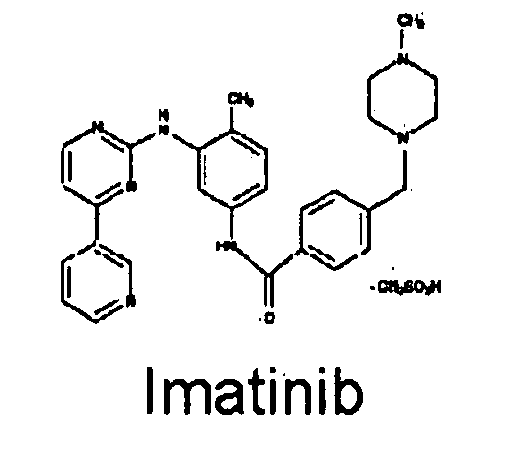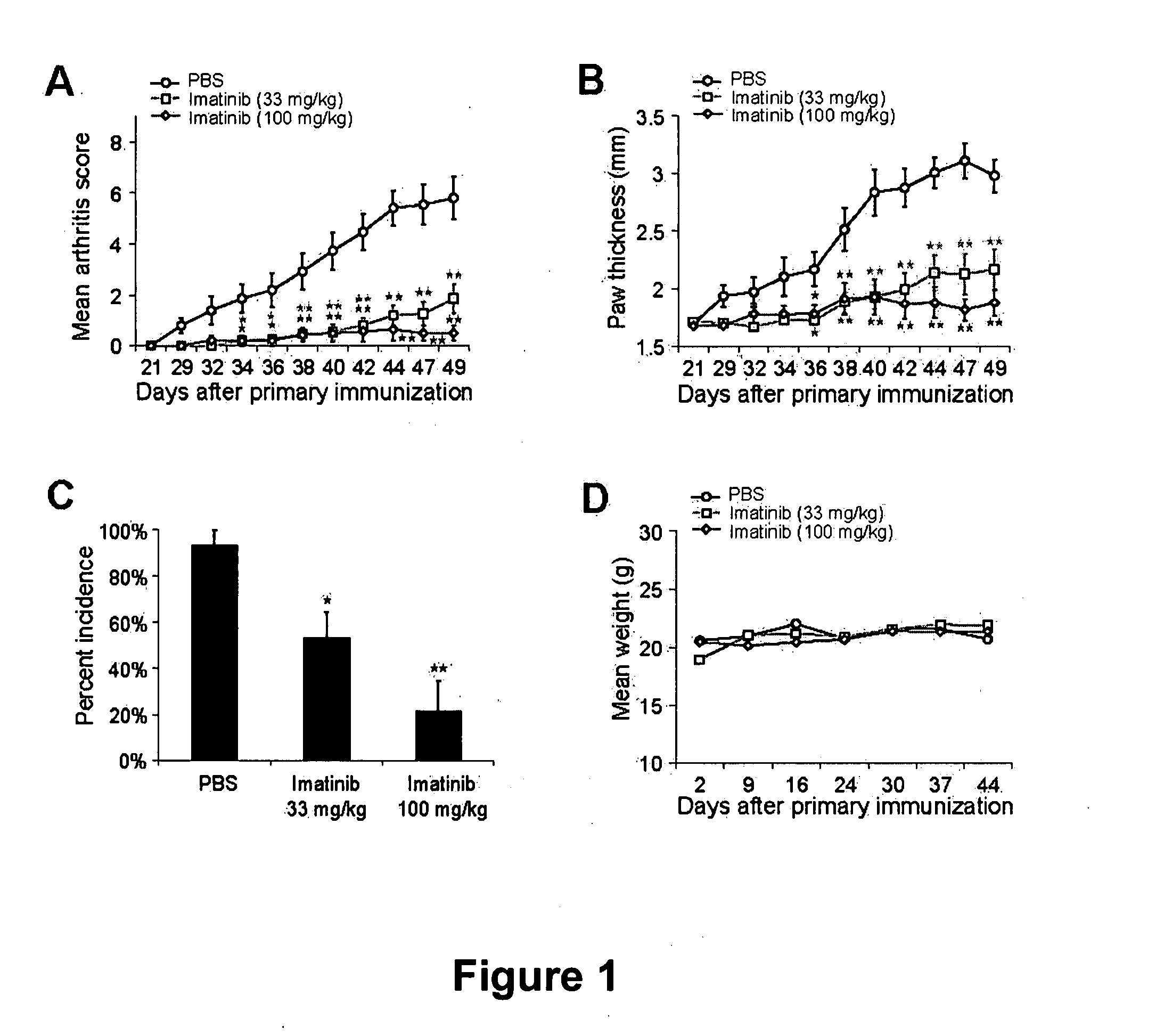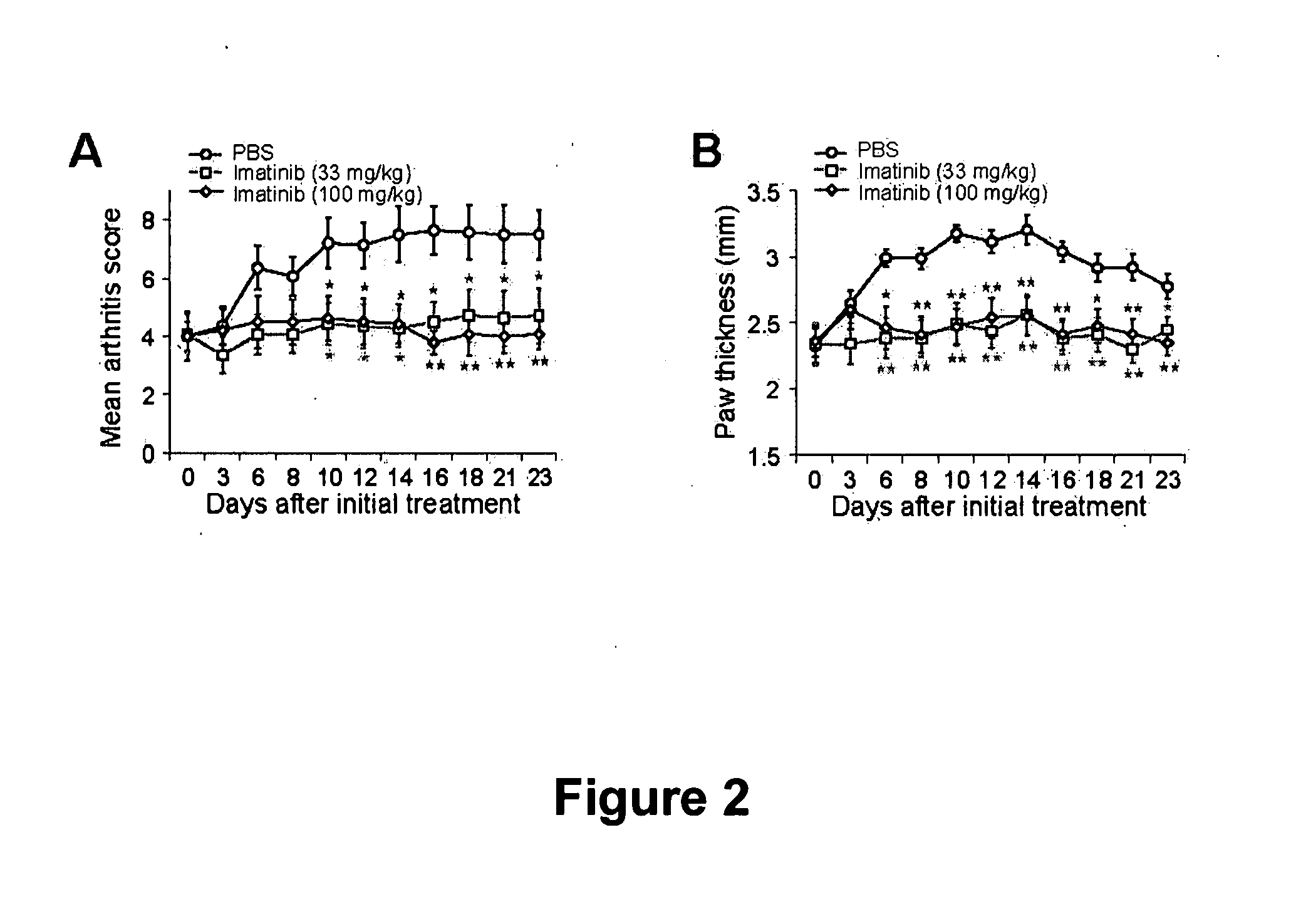Method of treating inflammatory diseases using tyroskine kinase inhibitors
a technology of tyrosine kinase and inflammatory diseases, which is applied in the field of treating inflammatory diseases with tyrosine kinase inhibitors, can solve the problems of uncontrollable cell growth and the development of chronic myelogenous leukemia (cml), lack of disease-modifying agents targeting the underlying pathogenesis, and restricted movement of joints in people with psoriasis
- Summary
- Abstract
- Description
- Claims
- Application Information
AI Technical Summary
Benefits of technology
Problems solved by technology
Method used
Image
Examples
example 1
Prevention of Collagen-Induced Arthritis with Imatinib
[0166] The ability of imatinib to prevent autoimmune arthritis in the collagen induced arthritis (CIA) model was evaluated as follows: CIA was induced by injecting DBA / 1 mice with bovine type II collagen (CII) emulsified in CFA, followed by boosting 21 days later with CII emulsified in incomplete Freund's adjuvant (IFA).
[0167] DBA / 1 mice (Jackson Laboratory) were administered phosphate buffered saline (n=15), 33 mg / kg imatinib (n=15), or 100 mg / kg imatinib (n=14) orally twice-daily starting one day prior to induction of CIA, based on the published pharmacokinetic profiles of imatinib metabolism in mice and humans (Druker, 2001; Buchdunger, 2001; Wolff, N. C., et al., Clin Cancer Res 10:3528-3534, (2004)). Imatinib is metabolized more rapidly in mice than in humans, and twice-daily oral dosing of mice with 100 mg / kg imatinib exhibits a similar pharmacokinetic profile as a mid-range dose of 400 mg once-daily in humans. This dosin...
example 2
Treatment of Collagen Induced Arthritis with Imatinib
[0170] The ability of imatinib to treat established autoimmune arthritis in the collagen induced arthritis (CIA) model was evaluated as follows. DBA / 1 mice with established clinical arthritis (average visual score of 4, CIA model as described in Example 1) were randomized and treated with 33 or 100 mg / kg imatinib or PBS. Progression of established arthritis was assessed by both a visual scoring system and mean paw thickness based on caliper measurements. The results, shown in FIGS. 2A-2B, show that both the 33 and 100 mg / kg dose levels of imatinib inhibited the progression of established arthritis as assessed by both the visual scoring system and mean paw thickness (p<0.05 after 10 days following the initiation of treatment; values are mean ± SEM. *P<0.05, **P<0.01 compared with PBS-treated mice).
[0171] Histopathologic analysis was performed on hind paws harvested from mice with CIA receiving imatinib or PBS in the prevention (E...
example 3
Effect of Imatinib on Mast Cell Production of Cytokines and Signaling
A. Presence of Mast Cells in Inflamed CIA Synovial Tissue
[0172] To confirm prior observations that mast cells are present in joints derived from mice with CIA (Kakizoe, E., et al., Inflamm Res 48:318-324, (1999)), sections of CIA joints were stained with toluidine blue. Toluidine blue is a metachromatic dye that stains the strongly sulphated acid mucopolysaccharide (heparin) content of mast cell granules. Toluidine blue staining revealed significant numbers of mast cells in inflamed CIA synovial tissue, as seen in FIG. 4A. Mast cells present in the densely inflamed CIA synovial tissue are indicated by arrows in FIG. 4A (B=bone, JS=joint space. Original magnification 200×).
B. Inhibition of Mast Cell Production of Proinflammatory Cytokines with Imatinib
[0173] The effects of imatinib on activation of the cloned murine mast cell line C1.MC / 57.1 (Young, J. D., et al., Proc Natl Acad Sci USA 84:9175-9179, (1987)) w...
PUM
| Property | Measurement | Unit |
|---|---|---|
| concentrations | aaaaa | aaaaa |
Abstract
Description
Claims
Application Information
 Login to View More
Login to View More - R&D
- Intellectual Property
- Life Sciences
- Materials
- Tech Scout
- Unparalleled Data Quality
- Higher Quality Content
- 60% Fewer Hallucinations
Browse by: Latest US Patents, China's latest patents, Technical Efficacy Thesaurus, Application Domain, Technology Topic, Popular Technical Reports.
© 2025 PatSnap. All rights reserved.Legal|Privacy policy|Modern Slavery Act Transparency Statement|Sitemap|About US| Contact US: help@patsnap.com



